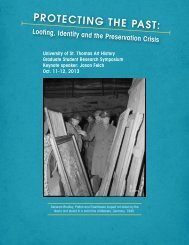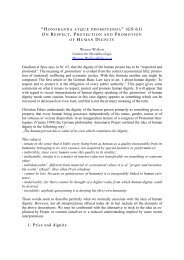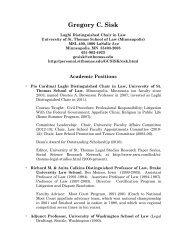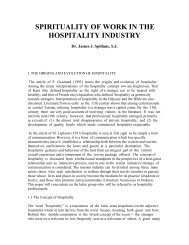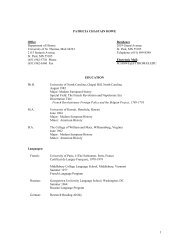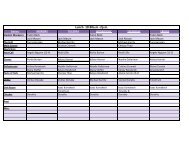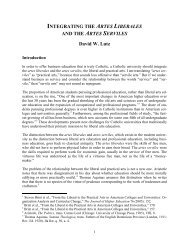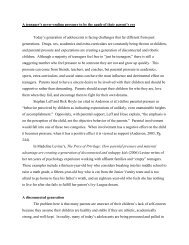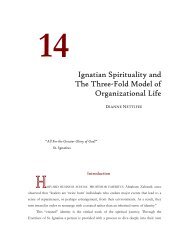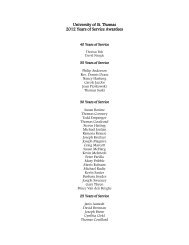dr. ronald e. mcnair acknowledgements - University of St. Thomas
dr. ronald e. mcnair acknowledgements - University of St. Thomas
dr. ronald e. mcnair acknowledgements - University of St. Thomas
Create successful ePaper yourself
Turn your PDF publications into a flip-book with our unique Google optimized e-Paper software.
UST McNair Scholars Program Research Journal<br />
Thailand or Laos. This study concluded that acculturation<br />
<strong>of</strong> foods, store types, conveniences, and English fluency<br />
were just some <strong>of</strong> the factors that contributed to the<br />
surveyed Hmong individuals and their food access and<br />
shopping behavior. 2 Improvements in the Hmong<br />
community with health and food are problems that need<br />
to be tackled.<br />
While the Hmong are still struggling to become<br />
accustomed to Western medicine and food, the need for<br />
healthy living is a concern for all. This is directly associated<br />
with improving access to healthcare. According to the<br />
American Public Health Association, “while the United<br />
<strong>St</strong>ates spends more on health care than any other nation in<br />
the world, it lags behind so many developed nations in<br />
important health measures.” 3 This particular statement<br />
shows how health and wellness is such an important role<br />
in our lives. Although money is spent for health purposes,<br />
the health <strong>of</strong> the country is still poor. Healthy practices are<br />
obtained with the availability <strong>of</strong> good, quality healthcare.<br />
According to Lora Todovora, MPH, “people’s health is<br />
closely related to access to health care.” 4 As health and<br />
wellness become a larger issue in today’s society, there is a<br />
concern about equal access to quality health and promotion<br />
to wellness.<br />
In this particular study, the large Hmong community<br />
in the Twin Cities metropolitan area <strong>of</strong> Minnesota was<br />
studied to determine their access to opportunities <strong>of</strong><br />
healthy living. This access to health and wellness was<br />
determined by locating and mapping four major aspects <strong>of</strong><br />
the promotion <strong>of</strong> health: healthcare facilities, food sources,<br />
and public transportation. First, the Hmong community<br />
was mapped to identify their location in relation to the<br />
area. Access to healthcare was determined by locating and<br />
mapping hospitals, clinics, dentists, and other healthcare<br />
facilities in the Twin Cities. As being healthy includes<br />
having the choice <strong>of</strong> nutritional, affordable, and quality<br />
food, grocery stores were mapped. Public transportation,<br />
such as buses, light rail, and bikeways were also mapped<br />
to provide affordable transportation to healthcare facilities<br />
and food sources. All these features provide an<br />
understanding <strong>of</strong> whether the Hmong community is<br />
geographically limited to healthcare access in the Twin<br />
Cities.<br />
This research is based on the geographical access <strong>of</strong><br />
healthcare in the community. Using the Geographical<br />
62<br />
Information System (GIS) in the <strong>University</strong> <strong>of</strong> <strong>St</strong>. <strong>Thomas</strong><br />
Geography Department, I propose that the Hmong<br />
community in the Twin Cities metropolitan area lacks<br />
geographical access to the promotion <strong>of</strong> a healthy lifestyle<br />
due to the poor access <strong>of</strong> healthcare, food sources, and<br />
public transportation.<br />
LITERATURE REVIEW<br />
In this section, I discuss the many different background<br />
studies surrounding my research. Knowledge <strong>of</strong> who the<br />
Hmong people are is significant, but there is also an<br />
understanding <strong>of</strong> how complimentary geography and heath<br />
are. This can be seen throughout various researches being<br />
done on the Hmong community, the fields <strong>of</strong> geography<br />
and public health, and the use <strong>of</strong> applications in GIS.<br />
THE HMONG PEOPLE<br />
The Hmong have traveled across the world as refugees<br />
<strong>of</strong> war and oppression. The history <strong>of</strong> the Hmong people,<br />
whether direct immigrants or descendents <strong>of</strong> immigrants,<br />
is ingrained in their culture. Ancestry <strong>of</strong> the Hmong is<br />
uncertain because <strong>of</strong> their oral and nomadic traditions.<br />
From research, they are thought to come from China,<br />
although those who have migrated to the United <strong>St</strong>ates<br />
have come from Laos, Vietnam, and Thailand. 5 Many<br />
American people were (and still are) unaware <strong>of</strong> the Secret<br />
War <strong>of</strong> Laos that occurred at the same time as the Vietnam<br />
War in the mid-1900s. As American men were fighting<br />
against the Vietnamese, Hmong men and boys were<br />
recruited by the U.S. Central Intelligence Agency (CIA) in<br />
the 1960s to battle the emergence <strong>of</strong> communism in Laos,<br />
the Pathet Lao. The U.S. with<strong>dr</strong>ew from Laos in 1975,<br />
abandoning the Hmong as communism took power. This<br />
created terror as “the Hmong became targets <strong>of</strong> retaliation<br />
and persecution.” 6 Re-education <strong>of</strong> the Hmong was ordered<br />
by the Pathet Lao through camps, and the Laos raged<br />
chemical warfare against the Hmong. Many Hmong fled<br />
to Thailand by crossing the Mekong River into the safety<br />
<strong>of</strong> refugee camps. Although out <strong>of</strong> the hands <strong>of</strong> the Pathet<br />
Lao, many did not leave until years after entering the<br />
refugee camps. Resettlement <strong>of</strong> the Hmong resulted in<br />
many moving to different parts <strong>of</strong> the world, such as France<br />
and the U.S., in the 1980s and years later. Many Hmong



